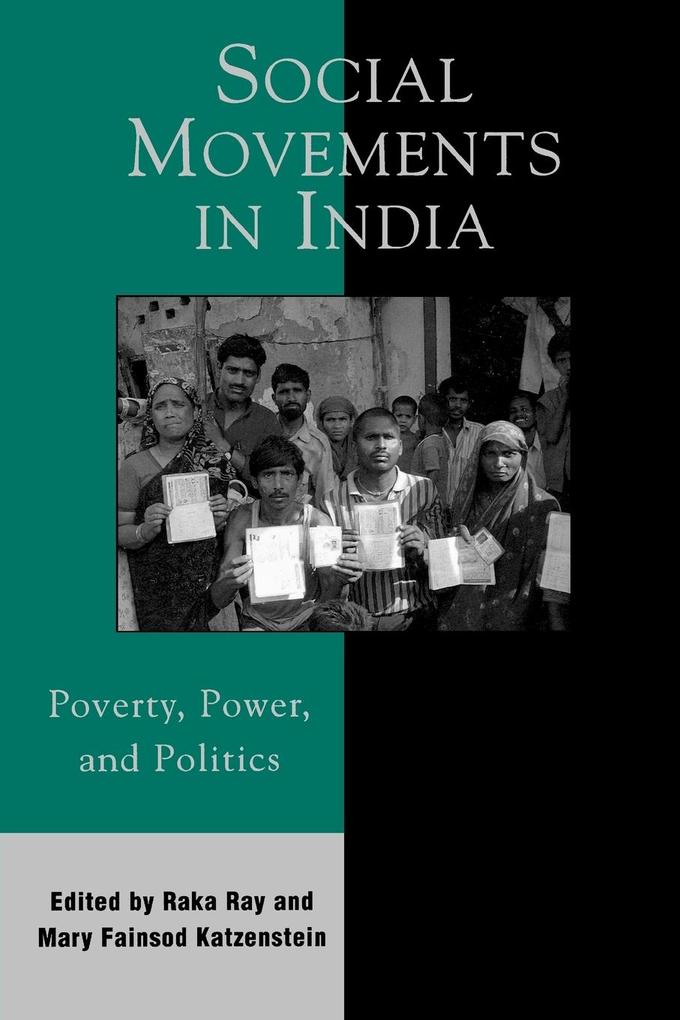
Zustellung: Sa, 24.05. - Mi, 28.05.
Versand in 6 Tagen
VersandkostenfreiBestellen & in Filiale abholen:
Social movements have played a vital role in Indian politics since well before the inception of India as a new nation in 1947. During the Nehruvian era, poverty alleviation was a foundational standard against which policy proposals and political claims were measured; at this time, movement activism was directly accountable to this state discourse. In the first volume to focus on poverty and class in its analysis of social movements, a group of leading India scholars shows how social movements have had to change because poverty reduction no longer serves its earlier role as a political template. With distinctive chapters on gender, lower castes, environment, the Hindu Right, Kerala, labor, farmers, and biotechnology, Social Movements in India will be attractive to students and researchers in many different disciplines.
Inhaltsverzeichnis
Introduction: In the Beginning, There Was the Nehruvian State
Chapter 1: From Class Compromise to Class Accommodation: Labor's Incorporation into the Indian Political Economy
Chapter 2: Problems of Social Power and the Discourses of the Hindu Right
Chapter 3: Reinventing Public Power in the Age of Globalization: The Transformation of Movement Politics in Kerala
Chapter 4: Feminism, Poverty, and the Emergent Social Order
Chapter 5: Who Are The Country's Poor? Social Movement Politics and Dalit Poverty
Chapter 6: Red in Tooth and Claw? Looking for Class in Struggles over Nature
Chapter 7: Farmer's Movements and the Debate on Poverty and Economic Reforms in India
Chapter 8: Miracle Seeds, Suicide Seeds, and the Poor: GMOs, NGOs, Farmers and the State
Chapter 9: Strong States, Strong NGOs
Chapter 1: From Class Compromise to Class Accommodation: Labor's Incorporation into the Indian Political Economy
Chapter 2: Problems of Social Power and the Discourses of the Hindu Right
Chapter 3: Reinventing Public Power in the Age of Globalization: The Transformation of Movement Politics in Kerala
Chapter 4: Feminism, Poverty, and the Emergent Social Order
Chapter 5: Who Are The Country's Poor? Social Movement Politics and Dalit Poverty
Chapter 6: Red in Tooth and Claw? Looking for Class in Struggles over Nature
Chapter 7: Farmer's Movements and the Debate on Poverty and Economic Reforms in India
Chapter 8: Miracle Seeds, Suicide Seeds, and the Poor: GMOs, NGOs, Farmers and the State
Chapter 9: Strong States, Strong NGOs
Mehr aus dieser Reihe
Produktdetails
Erscheinungsdatum
25. März 2005
Sprache
englisch
Seitenanzahl
320
Reihe
Asia/Pacific/Perspectives
Herausgegeben von
Raka Ray, Mary Fainsod Katzenstein
Verlag/Hersteller
Produktart
kartoniert
Gewicht
522 g
Größe (L/B/H)
229/152/19 mm
ISBN
9780742538436
Entdecken Sie mehr
Pressestimmen
This seminal anthology embeds the study of social movements just where it belongs, in the workings of state-society relations and democratic politics. It carefully charts changing patterns of social mobilization while identifying diverse and contradictory trends in each epoch. It underlines both the extraordinary significance of social movements and the extraordinary challenges of combining commitments to redistribution and poverty alleviation with other issues and identities. -- Amrita Basu, Amherst College This book is important to social movement scholars who wish to expand their theoretical boundaries by centrally considering lessons from "the South." -- Bandana Purkayastha Ph.D, University of Connecticut Mobilization This collection provides a valuable examination of Indian social movements and poverty in historical perspective and asks important questions about the role of social movements in the present, even if the answers are not so clear... It offers scholars interested in such movements in the era of globalization a range of cases with varying implications for poverty, and it invites India scholars to dig deeper to identify the outcomes of current social movement approaches. -- Jana Everett, University of Colorado Denver This collection provides a valuable examination of Indian social movements and poverty in historical perspectives and asks important questions about the role of social movements in the present ... This work offers scholars interested in such movements in the era of globalization a range of cases with varying implcations for poverty, and it invites India scholars to dig deeper to identify the outcomes of current social movement approaches. Perspectives in Politics This analytically sophisticated collection of work on what is arguably the world's most complex set of social movements will be a key source for future scholarship. Ray and Katzenstein's examination of how the evolution of India's political context has reshaped the panorama of Indian social movements has powerful comparative resonance. -- Peter Evans, University of California, Berkeley
Bewertungen
0 Bewertungen
Es wurden noch keine Bewertungen abgegeben. Schreiben Sie die erste Bewertung zu "Social Movements in India" und helfen Sie damit anderen bei der Kaufentscheidung.





























